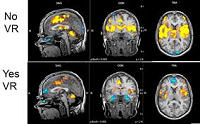 New experimental virtual reality (VR) applications are starting to be developed within rehabilitation settings to help people treat pain and anxiety.
New experimental virtual reality (VR) applications are starting to be developed within rehabilitation settings to help people treat pain and anxiety.
- Researchers from Ohio University developed a virtual dodgeball intervention designed to elicit graded increases in lumbar spine flexion while reducing expectations of fear and harm.
- The University of Washington Medicine Regional Burn Center at Harborview in Seattle has used VR therapy for distracting burn patients from excessive pain during wound care.
- Bloomberg recently published coverage on the effects that virtual reality has on Alzheimer’s and chronic pain.
There’s a lot more research needed before VR is going to be widely accepted as a pain relief method. Brennan Spiegel, a gastroenterologist at Cedars-Sinai who’s also director of health services research at the Los Angeles hospital, is about to begin a study on many more patients.
 The emerging field of bioelectronic medicine aims to target disorders traditionally treated with drugs and instead uses advanced neuromodulation devices that may offer significant advantages. In a recent
The emerging field of bioelectronic medicine aims to target disorders traditionally treated with drugs and instead uses advanced neuromodulation devices that may offer significant advantages. In a recent